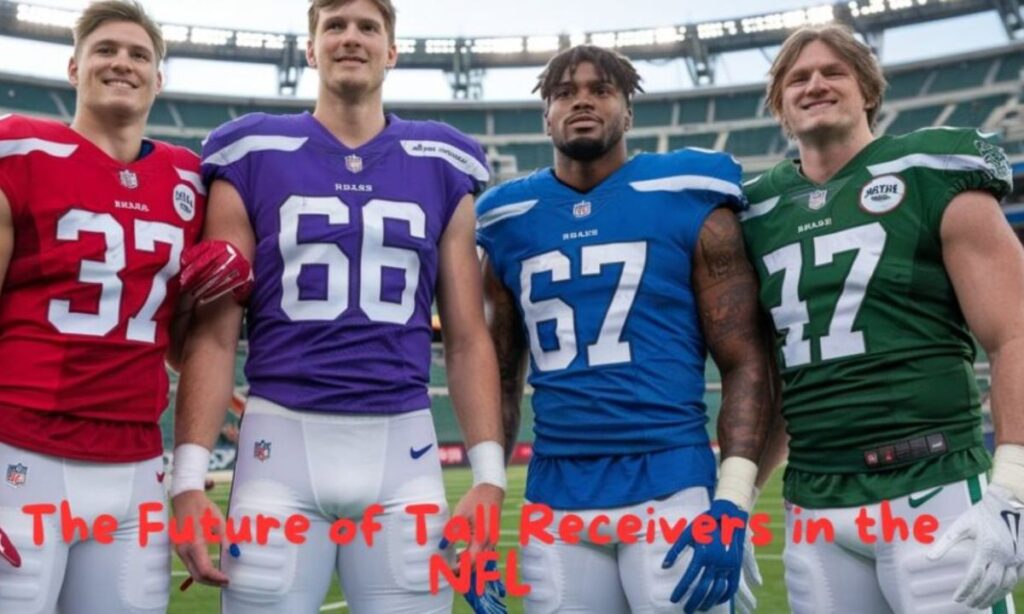In the competitive arena of the NFL, wide receivers are often celebrated for their speed and agility. However, there is a select group of players who stand out due to their impressive height.
As of 2024, four extraordinary athletes measure 6’5″, making them the tallest wide receivers in the league.These towering players are redefining the position and creating unique challenges for defenders.
Let’s explore the profiles of these giants and how they are making an impact on the game.
The Fantastic Four: Meet the 6’5″ Giants
While the average NFL wide receiver stands around 6’0″ tall, these four players tower above their peers. Their height gives them a distinct advantage on the field. Each of these athletes brings unique skills and qualities that contribute to their teams’ success.
| Player Name | Height | Team |
| Mike Evans | 6’5″ | Tampa Bay Buccaneers |
| Allen Lazard | 6’5″ | New York Jets |
| Equanimeous St. Brown | 6’5″ | Chicago Bears |
| A.T. Perry | 6’5″ | New Orleans Saints |
This table provides a clear overview of the tallest players in the NFL, highlighting their height and respective teams.
Mike Evans: Tampa Bay’s Touchdown Machine
Mike Evans is a dominant force for the Tampa Bay Buccaneers. Since being drafted 7th overall in 2014, he has consistently showcased his incredible skills. Evans has made history with his remarkable achievement of over 1,000 receiving yards in each of his first ten seasons. This feat is unmatched in NFL history and speaks volumes about his consistency.
Evans combines power and finesse in his playing style. His height makes him an ideal target in the red zone. He can outjump smaller defenders to secure touchdown passes. However, Evans is not just a red zone threat. He excels at route running and has strong hands, making him a versatile threat all over the field.
Read This Blog:Tampa Bay Rays vs New York Yankees Match Player Stats
Allen Lazard: New York’s Undrafted Gem

Allen Lazard’s journey to the NFL is a true testament to perseverance. After going undrafted in 2018, he signed with the Jacksonville Jaguars but was waived before the season began.
The Green Bay Packers recognized his potential and signed him to their practice squad. Lazard worked tirelessly and eventually became a key player in their offense.
His breakout season came in 2020. In just ten games, he recorded 451 receiving yards and three touchdowns. This performance proved that he could be a valuable asset to any team. Now with the New York Jets, Lazard brings a unique skill set to their offensive scheme.
Equanimeous St. Brown: Chicago’s Athletic Marvel
Equanimeous St. Brown is another impressive tall receiver in the NFL. Drafted in the sixth round by the Green Bay Packers in 2018, he has showcased flashes of brilliance throughout his career. His height and athleticism make him a unique asset on the field.
In his rookie season, St. Brown made an immediate impact with 21 receptions for 328 yards. Although injuries have hampered his progress, his potential remains evident. He possesses exceptional body control, allowing him to adjust to poorly thrown balls. This agility is remarkable for a player of his size.
A.T. Perry: New Orleans’ Rookie Sensation
A.T. Perry is the newest addition to the list of tall wide receivers. Drafted in the sixth round by the New Orleans Saints in 2023, Perry has already made a name for himself. His college career at Wake Forest University was impressive, featuring a remarkable season in 2021 with 71 receptions for 1,293 yards and 15 touchdowns.
Perry possesses exceptional leaping ability. Combined with his height, this makes him a nightmare for defenders on jump balls. He has strong hands and demonstrates a knack for making difficult catches in traffic. While still developing, Perry’s route-running potential is more diverse than many give him credit for.
The Height Advantage: Towering Over the Competition

The height advantage in football is a significant factor for wide receivers. Standing 6’5″ offers these players a unique set of skills that can change the dynamics of a game. Taller receivers excel in several areas.
One of the most notable advantages is their ability to outjump defenders. In one-on-one situations, especially in the end zone, taller receivers have a distinct edge in high-pointing the ball. This ability is crucial in scoring situations.
Another advantage is the expanded catch radius. Quarterbacks benefit from having a larger target area. Passes that might be uncatchable for shorter receivers are easier for tall players to secure. This allows quarterbacks to make riskier throws, knowing their tall receivers can make the catch.
Challenges and Adaptations
While height provides numerous advantages, tall receivers also face unique challenges. One common stereotype is that taller receivers lack speed. These athletes work hard to disprove this notion. Many have shown that they can compete with shorter, faster players.
Route-running precision can be a challenge as well. Longer limbs can make quick cuts more difficult. As a result, these players must focus on refining their technique to improve their agility. This requires dedication and hard work.
The Future of Tall Receivers in the NFL

As these 6’5″ receivers continue to dominate, they are changing perceptions about the ideal size for the position. NFL teams are increasingly valuing height in their receiving corps. This recognition stems from the mismatches that tall receivers can create on the field.
Defensive adaptations will also be necessary. Teams may begin to seek taller cornerbacks to counter these towering targets. This shift in player profiles reflects the evolving nature of the game.
Frequently Asked Questions
Who is the tallest wide receiver in NFL history?
While our featured receivers are all 6’5″, the tallest wide receiver in NFL history was Harold Carmichael, who stood at an impressive 6’8″.
Do tall receivers have longer careers in the NFL?
Career longevity depends on many factors beyond height, including skill and durability. However, tall receivers who consistently create mismatches may find sustained success.
How do teams defend against extremely tall wide receivers?
Defensive strategies often include double coverage, physical play at the line of scrimmage, and using taller defensive backs or linebackers to match up against them.
Are there any disadvantages to being a tall wide receiver?
Potential disadvantages include challenges with quick changes of direction and maintaining a low center of gravity, which can limit agility.
Which NFL team has the tallest receiving corps on average?
This can change with roster moves, but teams like the Tampa Bay Buccaneers and the New Orleans Saints are known for featuring taller receivers in recent years.
Conclusion
The four tallest wide receivers in the NFL—Mike Evans, Allen Lazard, Equanimeous St. Brown, and A.T. Perry—are more than mere statistical outliers.
They represent a shift in how the position is viewed and utilized in modern football. Their unique skills allow them to dominate in the red zone, win jump balls, and create mismatches against defenders.
In a league where every inch matters, these receivers are proving that sometimes, bigger really is better. The evolution of the NFL receiving corps reflects the changing dynamics of the game, and these 6’5″ giants are leading the way.

Smith is a talented content writer and digital marketer with expertise in SEO, social media management, and online marketing. She excels at creating impactful, data-driven content to help businesses connect with their target audience and achieve measurable outcomes.







